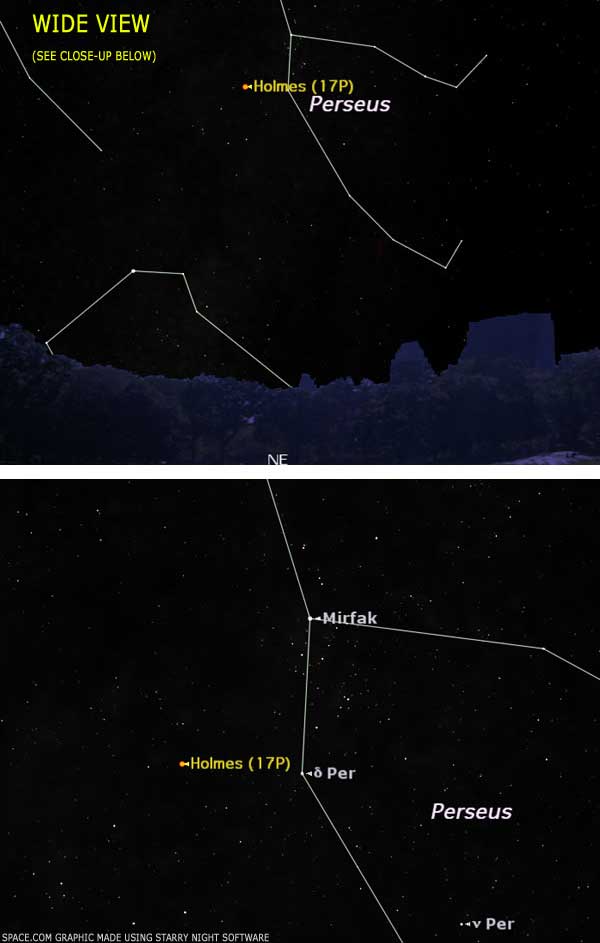Obscure Comet Brightens Suddenly

UPDATE 10/26: The comet has brightened futher [lastest update].
A small and very faint comet has surprised observers around the world by overnight becoming bright enough to see with the unaided eye.
Comet Holmes, which was discovered in November 1892 by Edwin Holmes, in London England, was no brighter than magnitude 17 in mid-October—that's about 25,000 times fainter than the faintest star that can normally be seen without any optical aid. In order to view an object this faint, one would need a moderately large telescope.
But the comet's brightness has suddenly rocketed all the way up to 3rd-magnitude, brightening nearly 400,000-times in less than 24-hours! On this astronomers scale, smaller numbers mean brighter objects. From urban locations, a 3rd-magnitude object might be hidden by light pollution, but under rural skies it would be clearly vsiible.
No tail
Comet Holmes is not as dramatic as some, lacking the characteristic tail that makes some of these frozen wanderers so beautiful. Instead, it appears as a fuzzy, albeit distinct, starlike object, but with no noticeable tail.
Bright moonlight can make it hard to find. But with a map and a small telescope, any relatively seasoned amateur should be able to spot it.
Breaking space news, the latest updates on rocket launches, skywatching events and more!
The comet is currently located among the stars of the constellation Perseus, which can be found about halfway up in the northeast part of the sky as darkness falls. Perseus is almost directly overhead by around 2 a.m. local daylight time and is still well up in the northwest sky as dawn begins to break.
Why Comet Holmes has undergone such an explosive outburst is not understood. What is amazing is that it made its closest approach to the sun last May, but came no closer than 191 million miles (307 million kilometers) to the sun. The comet is now moving away from the sun and currently is quite far out from Earth at a distance of 151 million miles (243 million kilometers). Not exactly a recipe for the typical show-off comet.
From deep space
This comet is part of Jupiter's "family" of comets—a group in which the far end of their respective orbits (aphelia) cluster around the orbit of Jupiter and takes 6.88 years to make one circuit around the Sun.
So why would a comet far out in the cold of space suddenly brighten hundreds of thousands of times? What is the source of such energy? Does it come from within the comet or without?
Alas, comets remain largely mysterious.
Comet Holmes is not alone in exhibiting anomalous effects. In the past, other comets have undergone unexpected outbursts in brightness. And this is probably not the first outburst for Comet Holmes: when it was discovered in 1892, it was likely in outburst mode, since it became as bright as fourth magnitude and was dimly visible to the naked eye.
"It appears that it is undergoing an outburst that strikingly parallels [a] famous 1892 event," said comet expert John Bortle.
Wednesday afternoon, Bortle said a report coming in from Japan suggested the comet was still brightening.
'Yellowish star'
Viewers all report the comet as appearing star-like, Bortle said, noting that observer Bob King, in Minnesota, said it looked "like a yellowish star."
Because of occasional close approaches to Jupiter, the orbit of Comet Holmes has been altered a few times. In fact the comet was considered "lost" for nearly 60 years before it was finally recovered with a large observatory telescope in 1964.
As to what this object will do in the coming days and weeks is not known. The brilliant light of the waxing Moon will be a hinderance for the rest of this week, but if you have binoculars or a small telescope, you might want to try seeing what certainly is one of the solar system's most enigmatic objects.
- The Greatest Comets of All Time
- Video: Comets Through Time ... Myths and Mystery
- Make Your Own Sky Map
Join our Space Forums to keep talking space on the latest missions, night sky and more! And if you have a news tip, correction or comment, let us know at: community@space.com.

Joe Rao is Space.com's skywatching columnist, as well as a veteran meteorologist and eclipse chaser who also serves as an instructor and guest lecturer at New York's Hayden Planetarium. He writes about astronomy for Natural History magazine, Sky & Telescope and other publications. Joe is an 8-time Emmy-nominated meteorologist who served the Putnam Valley region of New York for over 21 years. You can find him on Twitter and YouTube tracking lunar and solar eclipses, meteor showers and more. To find out Joe's latest project, visit him on Twitter.
